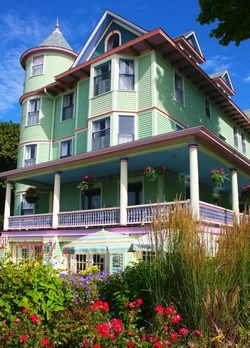The Legacy of Mackinac Island: Michigan’s First National Park
Introduction
Mackinac Island is a hidden gem in Michigan. It holds great historical and natural significance. The island is known for its charm, with no cars and beautiful scenery. Many people are unaware that it was the first national park in Michigan. This unique island has a rich history that dates back centuries. In this section, we will explore the island’s historical roots and its importance as a national park.
The Historical Background of Mackinac Island
Before becoming a park, Mackinac Island played a key role in history. Native American tribes were the island’s first inhabitants. They considered it a sacred place. Later, in the 1600s, the island developed into a significant French fur trading hub. Its location between Lake Huron and Lake Michigan made it valuable.
During the American Revolution, Fort Mackinac was built on the island. The British used it to control the Great Lakes region. In addition, the fort played a vital role in the War of 1812. After the war, the island’s military importance declined, but its natural beauty remained untouched. This paved the way for its preservation.
The Establishment of Mackinac as Michigan’s First National Park
In 1875, Mackinac Island became Michigan’s first national park. After Yellowstone, it was just the second national park in the United States. People recognized its natural beauty and wanted to protect it. The U.S. Army managed the park for 20 years. They oversaw its care and maintenance, keeping it pristine.
The park was given to the state of Michigan in 1895. This marked its transition from a national to a state park. It is currently one of the nation’s most popular state parks. The island’s natural landscapes and historic sites have been well-preserved. Its national park status helped secure its place as a key historical site.
Mackinac Island’s Natural and Cultural Beauty
The Natural Beauty of Mackinac Island
Mackinac Island is renowned for its breathtakingly beautiful scenery. The Great Lakes provide stunning views as soon as one arrives. The island is covered in lush forests, scenic trails, and limestone bluffs. These cliffs rise dramatically above the sparkling blue waters.
One of the most famous landmarks is Arch Rock, a natural limestone arch that offers panoramic views. Another notable formation is Sugar Loaf, a towering rock that adds to the island’s charm. The island’s scenery is a naturalist’s dream come true. Along the numerous pathways that meander through the shoreline and forests, visitors can go biking or hiking.
Mackinac Island is also home to diverse plant and animal life. Its protected environment allows various species of birds, plants, and animals to thrive. The island serves as a vital habitat for animals because many of its regions have not been impacted by modern development. Mackinac is a unique jewel in Michigan because of the dedication to maintaining its natural beauty.
Cultural and Architectural Legacy
Mackinac Island’s natural beauty is matched by its equally intriguing culture. The island’s buildings are a wonderful example of Victorian architecture. The historic houses and inns, with their brightly painted facades, transport visitors back in time. Launched in 1887, the Grand Hotel is among the most recognizable structures. It has the longest porch in the world and remains a symbol of the island’s elegance.
What sets Mackinac apart from other destinations is its transportation system. Cars have been banned on the island since the late 19th century. Instead, visitors travel by horse-drawn carriages, bicycles, or on foot. This unique feature adds to the island’s old-world charm and creates a peaceful environment.
Mackinac celebrates its rich history with festivals and events held all year long. One popular event is the Lilac Festival, which showcases the island’s blooming lilac trees. These traditions help keep the island’s cultural legacy alive, offering a deep connection to its past. The mix of nature, history, and tradition makes Mackinac Island a truly special place.
Mackinac Island Today and Its Lasting Legacy
The Modern-Day Impact of Mackinac Island
Mackinac Island has become one of Michigan’s most popular tourist destinations. Year-round tourism is fueled by its distinctive fusion of culture, history, and environment. Despite its popularity, the island has maintained its charm and peaceful atmosphere. Strict preservation efforts have kept its natural beauty intact. The absence of cars helps preserve its quiet, serene environment.
Tourism has helped the local economy thrive, but the focus remains on sustainability. The island’s leaders prioritize protecting the environment while welcoming visitors. This balance ensures that the island remains a treasured place for future generations.
Educational and Recreational Opportunities
Activities abound on Mackinac Island for guests of all ages. Historical tours of Fort Mackinac allow guests to step back in time. Historical-revival guides portray the 18th and 19th centuries’ way of life.
The island offers miles of beautiful hiking and biking trails for those who enjoy the outdoors. These trails offer stunning views of the forests and coastline. Additionally, boating, fishing, and lounging by the water are available to visitors.
Guided nature walks are among the educational events that educate guests about the island’s distinct ecosystem. These programs highlight the island’s flora, fauna, and geological features. The focus on both recreation and education makes Mackinac Island a well-rounded destination.
Ongoing Conservation Efforts
Mackinac Island continues to be a leader in conservation. Local and state officials work together to protect its natural and historic sites. An attempt is made to lessen the effect of tourists on the delicate ecosystems of the island. Initiatives to preserve the island’s history also ensure that its legacy will endure. These ongoing efforts help keep Mackinac Island a timeless treasure in Michigan’s landscape.
Conclusion
Mackinac Island offers a singular fusion of culture, environment, and history. It is significant in American history as the first national park in Michigan. Its natural beauty, historic sites, and peaceful environment continue to draw visitors. The island’s commitment to preservation ensures it remains a cherished destination. From its Victorian architecture to its scenic landscapes, Mackinac offers something for everyone. This island’s enduring history serves as a constant reminder to us of the value of safeguarding our cultural and natural resources for the enjoyment of future generations.
Category: Mackinac Island


